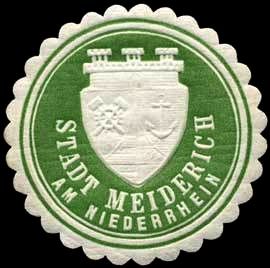Meiderich: Difference between revisions
Jump to navigation
Jump to search
Knorrepoes (talk | contribs) m (Text replacement - "{{de}}" to "") |
Knorrepoes (talk | contribs) m (Text replacement - "{| class="wikitable"↵|+Official blazon↵|-↵|'''German'''↵| ↵|-↵|'''English''' ↵| {{blazon wanted}}↵|}" to "{| class="wikitable" |+Official blazon |- |'''German''' | blazon wanted |- |'''English''' | blazon wanted |}") |
||
| Line 12: | Line 12: | ||
|- | |- | ||
|'''German''' | |'''German''' | ||
| | | blazon wanted | ||
|- | |- | ||
|'''English''' | |'''English''' | ||
| | | blazon wanted | ||
|} | |} | ||
Revision as of 08:31, 6 April 2023
MEIDERICH
State : Nordrhein-Westfalen
Incorporated into : 1905 Duisburg
| German | blazon wanted |
| English | blazon wanted |
Origin/meaning
The arms were granted in 1895.
The upper right corner shows a wheel and some miner's tools, symbols of the industry and mining in the area. The blue anchor symbolises the importance of shipping. The point shows the combined arms of the Myllendonck (black bars) and Stecke families, who ruled the town as vassals of the Dukes of Kleve.
The oldest seal of Meiderich dates from 1449 and shows the patron saint, St. George, killing the dragon, with besides him a shield woth the arms of the Stecke family. In 1478 the Myllendonck family acquired the estate through marriage. They ruled the town until 1633.
| Seal from around 1900 |
Seal from around 1900 |
Literature: Image and background provided by Joachim Beeck


